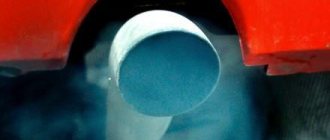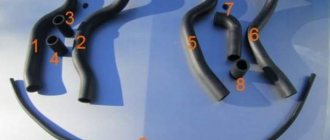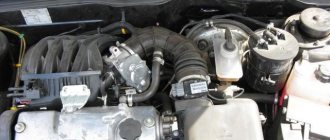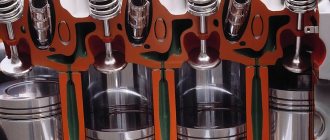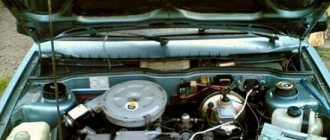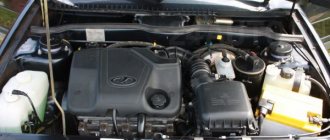Causes of malfunction
Before we begin to analyze the issue, it is worth understanding that the power unit requires certain components in order to function. An engine requires four components to run properly: air, fuel, spark and functioning electronics.
Based on this, you can determine exactly where the fault may be hidden and identify the main components. The VAZ 2115 engine is having problems with the 8-valve injector, where to look for the reasons:
- Sensors and ECU.
- Fuel, as well as its supply components.
- Air.
- Sparking.
How to identify the causes of engine tripping
The VAZ 2115 injector has “childhood diseases”, like all cars in principle. We'll talk about this a little later. The first step is to inspect the spark plugs. By removing the caps of the high-voltage wires one by one, you can determine which spark plug is not working; if the sound and rhythm of the engine does not change, it means that a faulty spark plug has been found and must be replaced. This operation must be performed with great care, as it may cause severe electric shock. The next reason is high-voltage wires. The engine is hot, the insulation of the wires is destroyed, and the wire begins to break through. Plus, sadly enough, the quality of spare parts is low. Only complete replacement of high-voltage wires helps in solving the problem.
Elimination methods
To correctly find the problem and fix it, the motorist should have knowledge of the design of the engine and its systems, as well as have the tools. A very indispensable element is time and hands growing from the right place. So, now you can begin to analyze the processes aimed at troubleshooting the problem.
Sensors and ECU
Many car repair mechanics recommend checking the software and meters, of which there are quite a lot in modern cars, before getting into the mechanical part.
So, first you should connect to the electronic engine control unit and carry out diagnostics using special software. The vehicle owner will need a USB-car cable, called K-line or OBD II, a tablet and the appropriate software.
After connecting and identifying the automotive equipment, it is worth carrying out diagnostic operations. If a software failure is detected, it must be removed and the system restored to functionality.
Also, the diagnostics will show which of the sensors has lost its functionality.
Which sensors are responsible for the normal operation of the engine, and their failure can lead to tripling of the power unit:
- Idle speed regulator. If this meter fails, then the engine will run cold. In this case, the engine will not only stall, but also have difficulty starting.
- Mass air flow sensor. Quite an expensive part in any car. Often, it does not fail, but the measuring grid becomes clogged. To restore operation, you need to clean the mesh.
- Crankshaft position sensor. It measures the number of engine revolutions, thereby regulating the supply of the amount of fuel mixture.
- The coolant temperature sensor affects the operation of the system indirectly, but can affect and create artificial tripping.
Fuel and its supply components
An integral element in the formation of the air-fuel mixture is fuel. So, not enough of it leads to the formation of a lean mixture, but too much of it leads to a rich mixture, which can flood the system.
The first thing you need to start diagnosing is the pump and filter. Clogged elements can lead to insufficient fuel reaching the injectors. The gasoline pump is located under the rear sofa, where it is quite easy to reach, but the filter element is mounted on the bottom behind the right rear wheel.
An injector is a fuel element that sprays fuel. The clogging of this unit affects the amount of fuel injected into the combustion chambers. Therefore, it is necessary to carry out diagnostics quite often. This is done using a special stand. If necessary, it is worth replacing the elements.
Air
Air supply elements are quite important because they directly affect the formation of the air-fuel mixture. So, a clogged throttle valve or its jamming will cause the car to suffocate, which will lead to the effect of tripping or it will stall. To clean this unit, it is necessary to dismantle the entire throttle valve. The part is cleaned using carburetor cleaning fluid.
An important element is the air filter. If it has not been changed for a long time or it is clogged ahead of time, then a tripping effect may be created. To eliminate the malfunction, you need to replace the dirty part with a clean new element.
Sparking
The last component that is involved in the normal operation of the engine is the spark generator. This unit includes: spark plugs and high-voltage wires.
Why does the VAZ-2115 engine troit, the 8-valve injector
If one of the cylinders completely refuses to work and the engine stalls, then during its operation you can hear the indignant grumbling of the engine.
“Boo-boo-boo” means it’s time to see a specialist. Moreover, you should not postpone this visit, since the wear of the motor in this case will be much stronger than during normal operation. If the engine stalls, its compression is significantly reduced, and all the necessary conditions are present for scuffing to occur on the pistons and cylinders. In this case, the operating temperature of the engine increases significantly, and therefore it begins to overheat. Without fully understanding all the nuances, it may seem that identifying such a malfunction is quite easy. But it also happens that the engine works absolutely normally, does not overheat and still starts to stall. In this regard, we will try to tell you point by point how to correctly diagnose and what you should first pay attention to in order to determine the cause of the engine tripping.
How to understand that the engine is troit
In principle, every car owner, even if it is his first car, knows it well. And it will be able to determine (by sound, for example) that there is a malfunction in the car. You can determine that the engine in a VAZ 2115 is faulty by the following “symptoms”:
When idling, the car experiences very noticeable vibrations. The engine operating cycle has changed (the sound of its operation will change), when you press the accelerator pedal, the car does not accelerate, this phenomenon may be accompanied by loud pops in the exhaust pipe and in the air filter. Increased fuel consumption as it does not burn. If the car owner notices such changes in the car’s operation, he must immediately contact the service center to eliminate them. Because initial repairs will be several times cheaper than repairs at an advanced stage.
But today we’ll look at why the engine is tripping. Many drivers nod their heads in agreement when they are told by the service center that the engine is misfiring, without understanding the essence of this phenomenon. Troit means that at least one cylinder is not working in the engine. This could be due to several reasons, which we will now look at.
Spark plugs are to blame
Most likely, the cause of the engine tripping is the spark plugs. In order to verify this fact, you should unscrew the spark plug from the cylinder and carefully inspect it. If the engine is operating correctly, the color of the side electrode, as well as the insulator, will be quite light. A brown tint is also allowed. A spark plug in this condition should be fully functional. But if the carbon deposits on the candle turn out to be black, then it simply cannot be working. It is either enriched with fuel or filled with oil.
Due to carbon deposits formed on the spark plug, it may not work at all or only work occasionally. Both the first and second options interfere with the normal formation of a spark.
The reasons for the appearance of carbon deposits on candles may be:
- the car engine has been idling for a long time or has been warming up for a long time;
- there is reduced compression in the cylinder;
- valve timing is shifted or disturbed;
- the injector is not working correctly;
- The oxygen sensor is faulty.
Next, it is imperative to pay attention to the housing in which the spark plug itself is placed. It should be completely white, without black dots or stripes. If, nevertheless, stripes or dots are visible on the body, this indicates that the spark plug is breaking through normally, but will not work.
But if, after inspecting the spark plug housing, nothing of the kind was found, you should check the spark while cranking the starter. To do this, a spark is inserted into the tip of a high-voltage wire and placed on the engine ground. The engine is cranked by the starter. At this time, you need to see if a spark jumps between the two electrodes of the spark plug. If it is visible to the naked eye and has a pronounced blue color, the candle is working correctly.
Replacement, performance check
For ease of access to the DS, it is better to drive the car into a pit or overpass, since it is easier to reach it from below. The only tools you need are 21 (22) and 10 keys, as well as a flat-head screwdriver.
You need to unscrew the DS counterclockwise. Since the sensor body is plastic, it can often be unscrewed by hand, but you may need to slightly loosen the fastening with a 21 (22) key.
We screw a new DS in place of the removed one, making sure that its pin fits into the hole in the actuator rod.
There is no need to tighten it with a wrench so as not to break the plastic thread; hand force is enough.
Sometimes problems with the operation of the sensor are not related to it, but to the drive. The fact is that some models use a plastic drive rod gear, and often its teeth “lick” themselves.
Therefore, when replacing the DS, it would not be superfluous to check the condition of the drive. To do this, after removing the sensor, you need to unscrew the drive mounting nut with a 10 mm wrench and carefully remove it, prying it slightly with a screwdriver.
It is important to ensure that the shock does not jump out and get inside the box.
After making sure that everything is in order with the drive gear, we install everything in place. Then we check whether the gears are engaged.
To do this, we jack up one front wheel, turn on speed 4 and ask an assistant to turn it, while we ourselves check with our fingers whether the rod rotates.
After checking the drive, screw on the DS and connect the wiring. All that remains is to check whether the symptoms of the malfunction have disappeared.
To do this, you can start the engine and monitor the behavior of the speedometer needle and listen to whether the interruptions in the operation of the power plant at idle have disappeared.
And then we just go out onto the highway and look at the behavior of the needle and the engine while driving.
Or you can check everything by measuring the voltage at the terminals with a multimeter.
Inspection of high voltage ignition wires
If it turns out that the spark plugs are in perfect order, this most likely means that the problem lies in the high-voltage wires.
In order to test this theory, it is necessary to consider each wire separately. First of all, you should pay attention to the tip of the wire that is inserted into the spark plug. It should be completely monochromatic and not have any plaque on it. The presence of foreign scale on it indicates that for some time this high-voltage wire worked in extreme mode. If this problem is not corrected in time, the wire may subsequently break, which will lead to much more serious problems and costs.
Injector malfunction
Trouble the VAZ-2115 engine? This may be due to faulty injectors. This happens if:
- the injector is faulty (this is quite rare);
- low-quality fuel is used;
- injectors require cleaning;
- The power or control circuits to the injector are shorted or completely broken.
If one of the sensors does not work, an error will appear on the dashboard, which will serve as a kind of scanner. But if the error does not appear, then the problem lies precisely in the mechanical part.
And it also happens that it is simply not possible to find the reason why the engine is tripping. In this case, it is necessary to use computer diagnostics of the car, after which the cause of the tripping will become completely clear. As a rule, a motor malfunction of this kind can only be detected by a specialist. Therefore, it is best to contact professional service centers. This will help save both time and your own money.
Source
conclusions
The bottom line is that it can be emphasized that the following malfunctions may be the reasons for the VAZ 2115 engine to fail:
- Spark plugs High-voltage wires Coarse fuel filter Burnt-out valve Broken cylinder head gasket Injector Crankshaft sensor Ignition module
Having discovered any of them, the car owner needs to contact a service center, where specialists will accurately determine the nature of the breakdown and be able to fix it. If the VAZ 2115 engine is malfunctioning and you do not have the proper experience, then you should not carry out repairs yourself, this can lead to an even greater deterioration in the condition of the car or injury to the technician himself!
Why troit 2115
What does “ TROIT” - this means that one of the cylinders is not working, in total there are 4 cylinders in the 2115 engine, when one of them fails, it turns out that only 3 cylinders are working, which is why they say that the engine is troiting. Sometimes it happens that two cylinders on a car stop working at once, then it turns out that the engine is running double, but no one says that, everyone says that the internal combustion engine is running triple.
There may be several reasons why the VAZ 2115 starts to triple and all of them, as a rule, are located in one place on the cylinder head.
The most common causes of VAZ 2115 engine tripping:
- Spark plug;
- High voltage wires;
- Ignition module;
- Crankshaft position sensor;
- Fuel injectors;
- Air leak;
Each of these parts or causes can seriously affect the performance of the engine and lead to the failure of one of the cylinders. Let's look at each of the reasons in more detail.
Spark plug
One of the most common reasons why a car starts to misfire is the spark plugs. According to the regulations, it is recommended to replace spark plugs no later than 30,000 km, which few people comply with, and sometimes they drive on spark plugs until they completely fail.
After prolonged use, spark plugs lose their properties, the gap between the electrodes increases, carbon deposits appear, the insulator cracks, etc. which leads to spark plug failure and, consequently, engine failure.
If the engine in your car starts to misfire, the first thing you need to do is replace the spark plugs with new ones; this will never be a bad thing, even if the reason is not them.
Conclusion
It has been determined that the reason why the VAZ 2115 engine fails is the lack of one of the important elements: fuel, spark or air. It was also found that a VAZ may stall when cold due to a malfunction of sensors, such as the idle air control.
I drove today with a faulty coil... The car really pissed me off, and I assumed that it was the ignition coil that was the problem, but I wasn’t 100% sure, in the end I decided to look for a known working coil in order to see if it was the problem. The engine was severely troubled, there were misfires in the first cylinder. Sometimes the second one fell off. There wasn’t really a spark on the first one, and due to errors it only showed gaps in the first boiler. The car practically did not pull, and when switching to 2-3-4-5 there was vibration, so much so that it was impossible to drive. I got out of the situation by driving at 3-4k rpm. But this is not the case at all, so I went to the store, took a new reel, agreeing to return it “if it doesn’t fit.”
I went out, connected the terminal, the explosive wires, I started it, there was no tripping, the engine ran smoothly and without any complaints. Great, I think, now I’ll change in about 10 minutes and go. Yeah, fuck!
In our domestic basins, everything is done in such a way that the horseradish can be unscrewed and there is no harm in doing so. Everything was used, the whole set of keys, a lock defrost, a rag and a great desire to strangle the one who designed it.
The essence of the whole story is that the coil is held on a mount, which in turn is attached to the engine with three bolts, 13, 15 and 17. In addition, you cannot easily get to them. The coil itself in the mount should sit on 4 bolts, straightened out with a hexagon, but for some reason there were only two of them.
First, I unscrewed the bolt by 15, it is located on top and it was easiest to get to it. After that, I started working on the 13 bolt, it is located on the right and access to it is limited by the tube through which antifreeze runs (whatever is the correct name) and the throttle cable. I got out of the situation by removing the throttle cable (two bolts securing it in the manifold). It became easier, but still hemorrhagic. Somehow I unscrewed it. The third one, at 17, I just fucked it up. It is located at the bottom, and it’s definitely not easy to get there; I had to remove the tube going from the cylinder head to the engine, which was also in the way. Okay, I took it off, unscrewed it, saw the hex bolts, went to the store to get a hex head, bought it, tried to unscrew it, but it didn’t work... I had to fill the bolts with water so that the hex head wouldn’t rest on the oil and dirt. Somehow I took it off, it took an hour to do everything in -12 cold, I screwed the coil on and put everything back in the reverse order. For those who don’t know, the wires through the boilers go like this: to the left of the terminal on the coil is wire No. 1, therefore it goes to the 1st cylinder, and then 2, 3 and 4 wires go in a circle.


